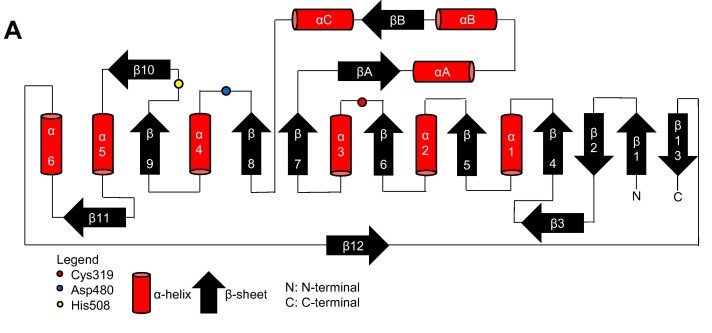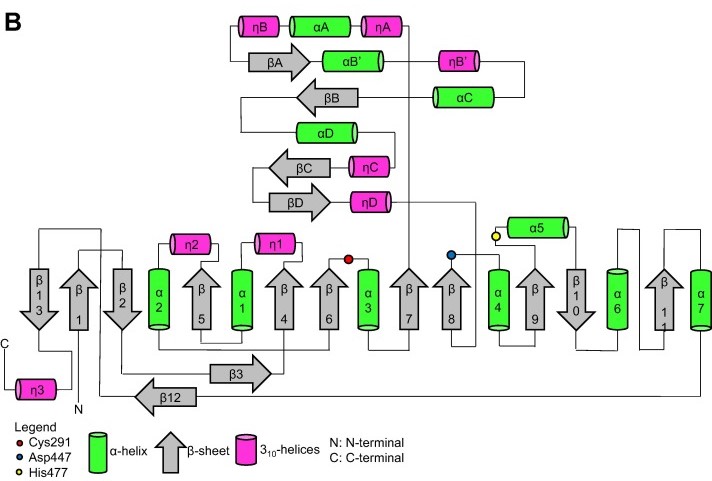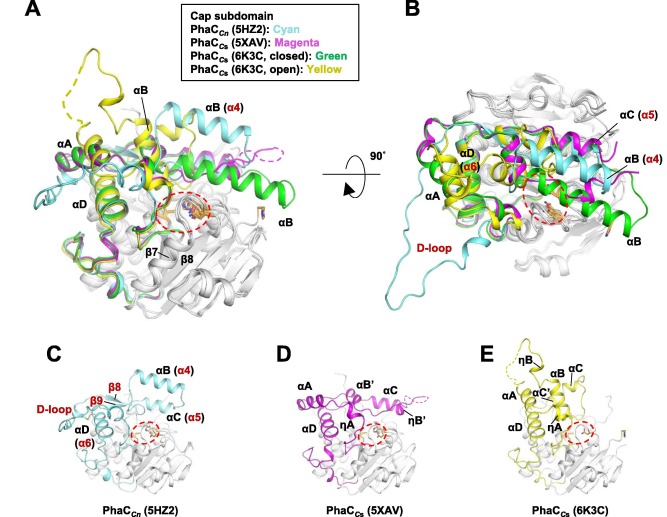User:Maria Júlia Pasian Ferreira/Sandbox 2
From Proteopedia
(New page: ==Introduction== <StructureSection load='1stp' size='340' side='right' caption='Caption for this structure' scene=''> Poli 3-hydroxyalcanoates (PHA) are the main components of the cytoplas...) |
|||
| Line 1: | Line 1: | ||
==Introduction== | ==Introduction== | ||
| - | + | ||
Poli 3-hydroxyalcanoates (PHA) are the main components of the cytoplasmatic inclusions, called PHA granules. They serve as carbon and energy reserves in many species of procariotes. PHA polymers can be made from different sized monomers, ranging from 4 to 14 carbon atoms. They are typically synthetized when there is an unbalanced distribution of nutrients in the medium, mainly an abundance of carbon sources coupled with the lack of another essential component. Among the existing PHAs, the most common are the poli-3-hydroxybutirate (PHB) polymers. (Barbosa, Gomez, Torres, 2018, p. 52). PHBs are specially relevant due to their properties that resemble conventional plastics, such as polypropylene. Since they are biopolymers made from renewable, biodegrabable and compatible source materials, PHBs present themselves as an industrial alternative to petrol-based plastics. (Byrom, 1987; Madison and Huisman 1999). | Poli 3-hydroxyalcanoates (PHA) are the main components of the cytoplasmatic inclusions, called PHA granules. They serve as carbon and energy reserves in many species of procariotes. PHA polymers can be made from different sized monomers, ranging from 4 to 14 carbon atoms. They are typically synthetized when there is an unbalanced distribution of nutrients in the medium, mainly an abundance of carbon sources coupled with the lack of another essential component. Among the existing PHAs, the most common are the poli-3-hydroxybutirate (PHB) polymers. (Barbosa, Gomez, Torres, 2018, p. 52). PHBs are specially relevant due to their properties that resemble conventional plastics, such as polypropylene. Since they are biopolymers made from renewable, biodegrabable and compatible source materials, PHBs present themselves as an industrial alternative to petrol-based plastics. (Byrom, 1987; Madison and Huisman 1999). | ||
The polymerization of PHA monomers is performed by the PHA sintase/polymerase (phaC) enzyme. At first, two acetyl-CoA molecules are condensed into one acetoacetyl-CoA by a β-ketoacyl-CoA thiolase, and then reduced to (R)-3-hydroxybutyryl-CoA by the acetoacetyl-CoA dehydrogenase. Finally, phaC polymerizes the (R)-3-hydroxybutyryl-CoA molecules into the PHA polymer. (Reddy et al., 2003). | The polymerization of PHA monomers is performed by the PHA sintase/polymerase (phaC) enzyme. At first, two acetyl-CoA molecules are condensed into one acetoacetyl-CoA by a β-ketoacyl-CoA thiolase, and then reduced to (R)-3-hydroxybutyryl-CoA by the acetoacetyl-CoA dehydrogenase. Finally, phaC polymerizes the (R)-3-hydroxybutyryl-CoA molecules into the PHA polymer. (Reddy et al., 2003). | ||
Currently, there are four known classes of phaC, that are distinguished by their primary structure, substrate specificity and subunits composition (Rhem, 2008; Neoh et al., 2022). Despite vast diversity, only the catalytic domain of the PhaC<sub>cn</sub>-CAT from ''Ralstonia eutropha'' H16 and the USM2 PhaC<sub>cs</sub>-CAT from the ''Chromobacterium'' sp., both being class 1 phaCs. (Neoh et al., 2022). | Currently, there are four known classes of phaC, that are distinguished by their primary structure, substrate specificity and subunits composition (Rhem, 2008; Neoh et al., 2022). Despite vast diversity, only the catalytic domain of the PhaC<sub>cn</sub>-CAT from ''Ralstonia eutropha'' H16 and the USM2 PhaC<sub>cs</sub>-CAT from the ''Chromobacterium'' sp., both being class 1 phaCs. (Neoh et al., 2022). | ||
| - | |||
| - | == more stuff == | ||
| - | This is a default text for your page '''Gustavo Sartorelli de Carvalho Rego/Sandbox 1'''. Click above on '''edit this page''' to modify. Be careful with the < and > signs. | ||
| - | You may include any references to papers as in: the use of JSmol in Proteopedia <ref>DOI 10.1002/ijch.201300024</ref> or to the article describing Jmol <ref>PMID:21638687</ref> to the rescue. | ||
== Class 1 == | == Class 1 == | ||
| - | === | + | <StructureSection load='5HZ2' size='350' side='right' caption='Crystal structure of PhaC1 from ''Ralstonia eutropha'' (PDB entry [[5HZ2]])' scene=''> |
The class 1 phaCs synthetize preferentially short chain PHAs, with 3 to 5 carbon monomers, and are composed by a single enzymatic unit, with molecular mass ranging from 63 to 73 kDA. (Chek et al., 2018; Neoh et al., 2022). | The class 1 phaCs synthetize preferentially short chain PHAs, with 3 to 5 carbon monomers, and are composed by a single enzymatic unit, with molecular mass ranging from 63 to 73 kDA. (Chek et al., 2018; Neoh et al., 2022). | ||
| Line 39: | Line 35: | ||
=== Quaternary structure === | === Quaternary structure === | ||
Quaternary structure of PhaC<sub>cn</sub>-CAT and PhaC<sub>cs</sub>-CAT, with the Cap subdomain highlighted. (Neoh et al., 2022). | Quaternary structure of PhaC<sub>cn</sub>-CAT and PhaC<sub>cs</sub>-CAT, with the Cap subdomain highlighted. (Neoh et al., 2022). | ||
| - | [[Image:Proteins-quaternary.jpg]] | + | [[Image:Proteins-quaternary.jpg]]</StructureSection> |
== Class 2 == | == Class 2 == | ||
Revision as of 23:26, 1 June 2024
Contents |
Introduction
Poli 3-hydroxyalcanoates (PHA) are the main components of the cytoplasmatic inclusions, called PHA granules. They serve as carbon and energy reserves in many species of procariotes. PHA polymers can be made from different sized monomers, ranging from 4 to 14 carbon atoms. They are typically synthetized when there is an unbalanced distribution of nutrients in the medium, mainly an abundance of carbon sources coupled with the lack of another essential component. Among the existing PHAs, the most common are the poli-3-hydroxybutirate (PHB) polymers. (Barbosa, Gomez, Torres, 2018, p. 52). PHBs are specially relevant due to their properties that resemble conventional plastics, such as polypropylene. Since they are biopolymers made from renewable, biodegrabable and compatible source materials, PHBs present themselves as an industrial alternative to petrol-based plastics. (Byrom, 1987; Madison and Huisman 1999). The polymerization of PHA monomers is performed by the PHA sintase/polymerase (phaC) enzyme. At first, two acetyl-CoA molecules are condensed into one acetoacetyl-CoA by a β-ketoacyl-CoA thiolase, and then reduced to (R)-3-hydroxybutyryl-CoA by the acetoacetyl-CoA dehydrogenase. Finally, phaC polymerizes the (R)-3-hydroxybutyryl-CoA molecules into the PHA polymer. (Reddy et al., 2003).
Currently, there are four known classes of phaC, that are distinguished by their primary structure, substrate specificity and subunits composition (Rhem, 2008; Neoh et al., 2022). Despite vast diversity, only the catalytic domain of the PhaCcn-CAT from Ralstonia eutropha H16 and the USM2 PhaCcs-CAT from the Chromobacterium sp., both being class 1 phaCs. (Neoh et al., 2022).
Class 1
| |||||||||||
Class 2
Among the 4 classes of phaC, the class 2 enzymes are the only that synthetize preferentially medium chain PHA, with 6 to 14 carbon monomers. Just like the class 1, they are also formed by a single enzymatic subunit, however, its molecular mass is, in general, higher than class 1 phaC, with approximately 62 kDa. It is suggested that the class 2 molecules also have two domains. (Chek et al., 2018).
Class 3
The class 3 phaC produce preferentially short chain PHAs, with 3 to 5 carbon monomers. However, differently from classes 1 and 2, they recquire an additional subunit, the phaE, and has a smaller molecular mass ranging from 40 to 53 kDa. (Chek et al., 2018; Jia et al., 2016).
Class 4
Just like class 3, the class 4 is also composed by two enzymatic units, phaC (catalytic subunit) and phaR, and has a smaller molecular mass than the other classes. The class 4 phaC also produce preferentially short chain PHAs, with 3 to 5 carbon monomers.
stuff
This is a sample scene created with SAT to by Group, and another to make of the protein. You can make your own scenes on SAT starting from scratch or loading and editing one of these sample scenes.
</StructureSection>



